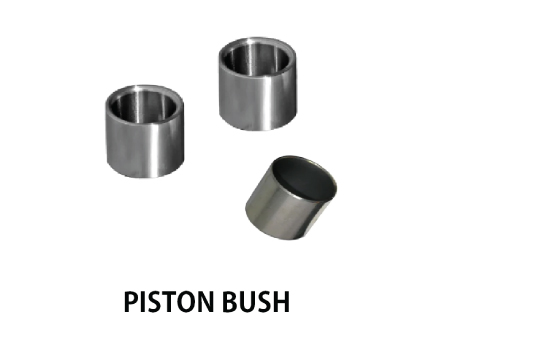-
Call
-
Whatsapp
9825014048
-
Location


Piston Compressor Bush
Piston Compressor Bush
An important component of mechanical systems is a piston bushing, which reduces friction, ensures proper alignment, and extends the life of piston-driven machines. This is true whether you're running an engine, hydraulic systems, or the mechanical equipment application. We will explore the world of piston bushings in this comprehensive guide, exploring their functions, types, materials, and applications.
Piston bushings, also called bushings or plain bearings, are cylindrical components that act as bearing surfaces for pistons or rods in mechanical systems These parts are designed to reduce friction, take radial and axial loads, and provide laterality the movements are perfectly aligned.
Piston bushings perform several important functions in industrial systems:
Functions of Piston Bushings
Compressed air systems can use a variety of contaminants such as dirt, dust, water and even particles. Over time, these contaminants can find their way into the lubricating oil, posing a serious threat to compressor integrity. Screw-compressor oil filters are specially designed to remove these contaminants, ensuring that the oil circulating in the compressor remains clean and clean
- Friction Reduction: One of the main functions of a piston bushing is to reduce friction between the piston or rod housing. By providing a smooth and low-density surface, they ensure efficient operation without wasting energy.
- Load Distribution: The piston bushings distribute the radial load uniformly over the bearing surface. This prevents local stress, thereby extending the life of the components and reducing the risk of failure.
- Axial Alignment: They help maintain proper axial alignment between the piston or rod and the housing, preventing misalignment problems that can lead to material wear and shrinkage.
- Shock and vibration damping: Piston bushings can absorb and absorb shock and vibration, which is important in applications such as shock absorbing hydraulic systems to ensure stability and comfort.
- Lubricant storage: In some cases, piston bushings can store lubricant, reducing the need for constant lubrication and maintenance.
Different Types of Piston Bushing
Piston bushings come in a variety of styles, each designed for a specific application and operating conditions. The most common types are:
- Sleeve Bearing: A sleeve bearing is a circular bushing with a smooth hole. They are generally used in low speed, high load applications and can be made of a variety of materials including copper, brass, and plastic.
- Flanged Bearings: Flanged bearings have a flange or collar at one end which acts as a stop to prevent axial movement. These are typically used in areas where axial stability is critical.
- Thrust Bearings: Thrust Bearings are designed to handle axial loads and are usually used with radial bushings to absorb both radial and axial forces.
- Spherical Bearings: Also called spherical plain bearings, can accommodate misalignment and are used in applications where articulation or angular movement is important.
- Split Bearings: Split bearings have a two-piece design, making them easy to install and replace without disassembling the entire system. Large industrial applications commonly use it.
Material Used in Piston Bushings
The choice of material for piston bushings depends on factors such as weight, speed, temperature, and environmental conditions. Common uses include:
- Bronze: Bronze bars are known for their excellent wear and corrosion resistance. It is commonly used in high volume and slow speed applications.
- Brass: Brass bushings provide excellent wear resistance and are suitable for medium load and high speed applications.
- Steel: Steel bars are known for their hardness and durability. Used in complex, high speed applications.
- Plastic: Plastic bushings, such as nylon and PTFE (Teflon), are chosen because of their frictionless and self-lubricating properties. Used where lubrication can be difficult.
Installation and Maintenance
Proper installation and maintenance of piston bushings is essential to ensure proper performance and longevity. Here are some key considerations:
- Precise Fit: Make sure the bushing housing is aligned to prevent misalignment and premature wear.
- Lubrication: Many bushings require lubrication to reduce friction and prevent overheating. The amount and frequency of lubrication depends on the materials used and the application.
- Inspection and Replacement: Check the towel regularly for signs of wear such as increased friction, noise, or play. Replace damaged wood immediately to prevent further damage to the system.
Piston Bushings
Applications of piston bushings are wide across industries and systems, e.g.
- Automotive: In an engine, piston bushings reduce friction and ensure proper alignment of the pistons in the cylinder.
- Hydraulic System: A hydraulic cylinder relies on a piston bushing for easy and accurate movement of the piston into the cylinder.
- Industrial machinery: Piston bushings are used in a variety of industrial machinery, including conveyors, presses and agricultural machinery.
- Space: Piston bushings are used in landing gear systems, actuation mechanisms, and aircraft control systems in aerospace applications.
- Marine: In marine applications, piston bushings are used in ship propulsion systems, steering systems and winches.
- Construction and Heavy Equipment: Construction equipment, such as excavators and bulldozers, rely on piston bushings for reliable performance in steep slopes.
Piston bushings are key components of many industrial systems, serving important functions such as reducing friction, distributing weight and ensuring proper alignment Bushing types and materials selected depend on specific applications and operating conditions on.
By properly understanding the function, types, materials, and maintenance of piston bushings, engineers and operators can ensure efficient and reliable system performance in a variety of industries , to increase machine life and reduce downtime


FAQ

Frequently Ask Questions
A piston compressor bush is a component that provides support and reduces friction for the piston within a compressor.
The piston compressor bush plays a crucial role in maintaining smooth operation and extending the lifespan of the compressor by reducing wear and tear on moving parts.
The frequency of replacement depends on factors such as usage intensity and environmental conditions. It's recommended to inspect the bush regularly and replace it if signs of wear or damage are observed.

